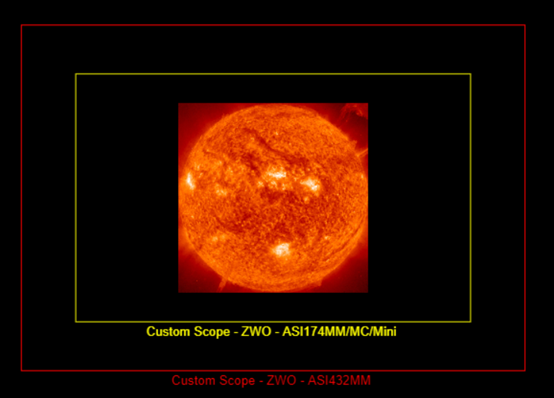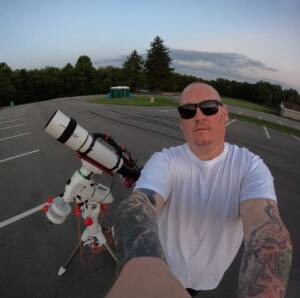
Discovery of the M31 [OIII] emission arc
Recently, a major discovery by an international team of amateur astronomers and scientists has become a huge online hit, and this new discovery is just located in one of the

The total solar eclipse in April 2024 is just around the corner. According to NASA, the next visible total solar eclipse to cross over the U.S. after April will come in more than two decades on Aug. 23, 2044, making it an unmissable opportunity for astronomy enthusiasts. Are you ready for it?
If you plan to observe it visually, specialized solar eclipse glasses are essential and must be carried with you before departure. If you intend to capture this spectacle with photography equipment, then what equipment to bring becomes a matter of careful deliberation.

Considering that astronomy enthusiasts living in the core zone of the total solar eclipse path are still a minority after all, most of them live outside the path of the total solar eclipse, and need to travel a long way to a specific area such as Texas in the United States, to watch the total solar eclipse. Therefore, when selecting equipment, we need to follow the principle of lightweight, easy to carry and easy to operate.

Here we list a few pieces of ZWO equipment that are better suited for traveling to photograph a total solar eclipse, covering cameras, telescopes, alt-azimuth mount, tripod, and imaging controllers.
Let’s start with the cameras: ZWO’s professional CMOS solar imaging cameras are currently available in two models: the ASl432MM and the ASl174MM, both of which feature large sensor formats: the ASl432MM has a sensor format of 1.1″ and the ASl174MM has a sensor format of 1/1.2″. Why large sensor format? It is because the Sun is a much larger target than any other planets in the solar system. With a 600mm telescope, the ASl432MM and ASl174MM can easily fit the entire Solar surface into the image frame.


Secondly, both cameras have another important advantage: the global shutter. In a global shutter system, all pixels in the camera sensor are exposed to light simultaneously and for the same duration, whereas in a rolling shutter system, the exposure occurs sequentially from the top to the bottom (or vice versa) of the camera sensor. This means that different parts of the image are exposed at slightly different times, resulting in potential distortion or skewing of moving objects, especially when there is rapid motion. It is commonly known as the “jelly effect”.
The image below is a typical jelly effect image, where the image is distorted when photographing a fan blade moving at high speed.

When capturing the Sun, even slight movements, whether from the Sun’s own motion or from disturbances like wind blowing or accidentally bumping the tripod, can be magnified in our images. When using a rolling shutter camera for such captures, it’s easy to encounter issues like the “jelly effect,” where images appear distorted and warped.
To address this, there are two main solutions: increasing the camera’s frame rate as much as possible and switching to a global shutter camera. The ASI174MM camera can achieve a maximum frame rate of up to 164fps at full resolution, while the ASI432MM can reach up to 120fps at full resolution. Both cameras boast high frame rates, coupled with a global shutter, making them ideal for capturing total solar eclipse.
The following are the specifications for the ASI432MM and ASI174MM cameras. The ASI432MM actually has advantages over the ASI174MM, including a larger sensor, lower read noise, larger pixel size, and greater full well capacity. However, the ASI174MM has been available for many years and is highly favored by solar photographers. Therefore, both cameras are excellent choices.

Considering our principle of lightweight travel, the ZWO FF65 APO is an excellent choice. Paired with either the ASI432MM or ASI174MM, you can achieve a relatively large field of view.

Additionally, the FF65 APO feature a self-flatfield design, making it ideal for astrophotography purposes. Once focused, it is ready for imaging without the need for complex connection processes. This makes it extremely convenient and easy to use. You can use it with solar filter for visual observation or attach a camera for photography purposes.

You can use a simple tripod to carry the telescope and camera, but this is not our recommended solution. Common tripods in the market typically have limited load capacity, weak wind resistance, and most importantly, they lack the ability to track the object. The solar eclipse lasts nearly three hours. So if you want to capture the entire event, you may need to adjust the tripod every few minutes to keep the Sun in your screen. A slight oversight could lead to the Sun drifting out of the camera’s field of view. Therefore, we recommend using ZWO’s equatorial mount AM3 for better stability and tracking capability.

The AM3 utilizes specialized strain wave gears designed for astrophotography, offering extremely low periodic error, smooth transmission, and high torque. With a weight of 3.9kg for the AM3 is relatively portable. Additionally, due to the characteristics of the strain wave gear, the mount does not require balancing before imaging and do not need to add counterweight as long as the entire weight of the OTA and camera is within the payload range. The mount feature equatorial and altazimuth mode. When photographing a solar eclipse, we can first adjust the mount to altazimuth mode, point it toward the Sun, then calibrate and activate tracking within the ASIAIR app on our mobile device. Afterward, the AM3 will automatically track the Sun, ensuring it stays centered in the frame.
When using the AM3 mount, you can pair them with the TC40 carbon fiber tripod. It is lightweight, weighing only 2.3kg. Its telescopic design allows it to extend up to 80cm when unfolded and collapse to just 47cm when stowed, making it easy to transport in a car trunk.

So why choose ASIAIR? ASIAIR allows us to complete all imaging processes on our smartphones. We don’t need to constantly monitor the screen during the solar eclipse. Simply set up solar tracking, then enter the planetary mode in ASIAIR, click on the option for video recording, and let the smartphone handle the imaging process, freeing up your hands. During the precious phase of the total solar eclipse, put on your specialized solar eclipse glasses, attentively enjoy the special moment, while ASIAIR captures the entire process for you.

ASIAIR provides a comprehensive astrophotography workflow solution. As mentioned earlier, when paired with the AM3 mount, it can continuously track the Sun. With the Electronic Automatic Focuser (EAF) integrated, it allows for focusing directly from your smartphone, eliminating the need for manual focusing adjustments on the telescope that may introduce shaking, ensuring a stable view of the Sun in the frame.
Due to the multiple stages of a total solar eclipse, we would like to share some small TIPS taken for you. During the partial eclipse phase, we recommend using a 10-second time lapse. During the second contact phase, we recommend using continuous shooting at high-speed. The specific shooting time depends on the camera and telescope you are using. If you can capture the Baily’s beads and solar prominence, one’s trip wasn’t for nothing. As the day of the total eclipse enters the total eclipse stage, we recommend that you perform image stacking after taking single shots.
Adhering to the principle of portability, let’s briefly calculate the weight of the equipment mentioned above. If you opt for the 65APO, paired with the AM3 and TC40 tripod, the total weight would be approximately 13 kilograms. Compared to traditional astronomical photography equipment, both setups are relatively lightweight, making them easy to store in the trunk of a vehicle. Once on-site, they can be quickly set up without spending too much time on equipment adjustments, allowing for a prompt start to photography.
Please do not use binoculars, telescopes, or naked eyes to observe the sun without special protective measures. Take good eye protection measures and wear solar eclipse observation goggles or filters for observation.
With the total solar eclipse just a few days away, we wish all astronomy enthusiasts a fantastic experience enjoying this rare spectacle. If you’re interested in the recommended products mentioned above, you can always check the ZWO official website for detailed information and purchase equipment from local authorized dealers. Click here to view the list of authorized ZWO dealers worldwide.

Recently, a major discovery by an international team of amateur astronomers and scientists has become a huge online hit, and this new discovery is just located in one of the

Hello,Sara Harvey,thanks for accepting our interview invitation. Congratulations on winning the ASIWEEK competition in week! Q1: At first, congratulation that your nice image won #ASIWEEK. Can you introduce yourself to

Astrophotography is more than just capturing images of the night sky—it’s a journey of discovery, patience, and creativity. For this passionate astrophotographer, what started as a chance encounter with a

Taranjot Singh, an Indian origin Australian astrophotographer who is making waves on the international stage. Taranjot has been recognized as one of the Top 5 finalists in the prestigious Siena

The back focal length is advised by telescope manufacturers. Since most telescopes have a 55mm back focal length, we are here to provide detailed instructions for all ASI cooled cameras.Please

How to connect ASI6200MM Pro to 2″ EFW/M54 filter drawer and OAG-L? How many solutions are there for ASI6200MM Pro to get 55mm back focus length? If you are still